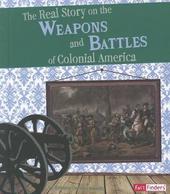
|
Real Story on the Weapons and Battles of Colonial America (Life in the American Colonies)
Paperback / softback
Main Details
| Title |
Real Story on the Weapons and Battles of Colonial America (Life in the American Colonies)
|
| Authors and Contributors |
Consultant editor Samuel Hoff
|
|
By (author) Kristine Carlson Asselin
|
| Physical Properties |
| Format:Paperback / softback | | Pages:32 |
|
| ISBN/Barcode |
9781429679855
|
| Classifications | Dewey:973.2 |
|---|
| Audience | |
|---|
| Illustrations |
Illustrations, unspecified
|
|
Publishing Details |
| Publisher |
Capstone Press
|
| Imprint |
Capstone Press
|
| Publication Date |
1 January 2012 |
| Publication Country |
United States
|
Description
Travel back to a time when: Canon balls were the only weapons of mass destruction. An arrow was more accurate than a gun. Step into the lives of the colonists, and learn the real story of the weapons and battles of colonial America.
Author Biography
Kristine Carlson Asselin writes both fiction and nonfiction for children and teens. She is the author of more than fifteen children's books for the elementary school library market and her debut YA novel ANY WAY YOU SLICE IT (Bloomsbury Spark) came out in April 2015. Kris volunteers with the Girl Scouts of Eastern Massachusetts, and loves Harry Potter, Doctor Who, classic rock from the 70's and 80's, and anything with a time travel theme. She loves doing workshops and talking about reading and writing with both kids and adults. Kristine lives in a suburb of Boston, Massachusetts with her husband and daughter.
Reviews"Getting lost" in history is our wish for young researchers, and students will do just that in this series. They will find plenty of information included in fact boxes, primary source materials, maps, photos, drawings, and paintings. The series consistently shows what is familiar and foreign to the modern reader; respectfully incorporates how slavery and minority groups were treated and integrated in American colonial life; and outlines gender and generational roles. Each volume progresses chronologically, beginning with first European settlers and concluding in the mid-1700s. Because of the descriptions of familiar topics set historically, kids will make an instant connection. Useful not only for history, but science, social studies, and other classes, students will enjoy comparing their life to early colonists. Recommended.-- "Library Media Connection"
|